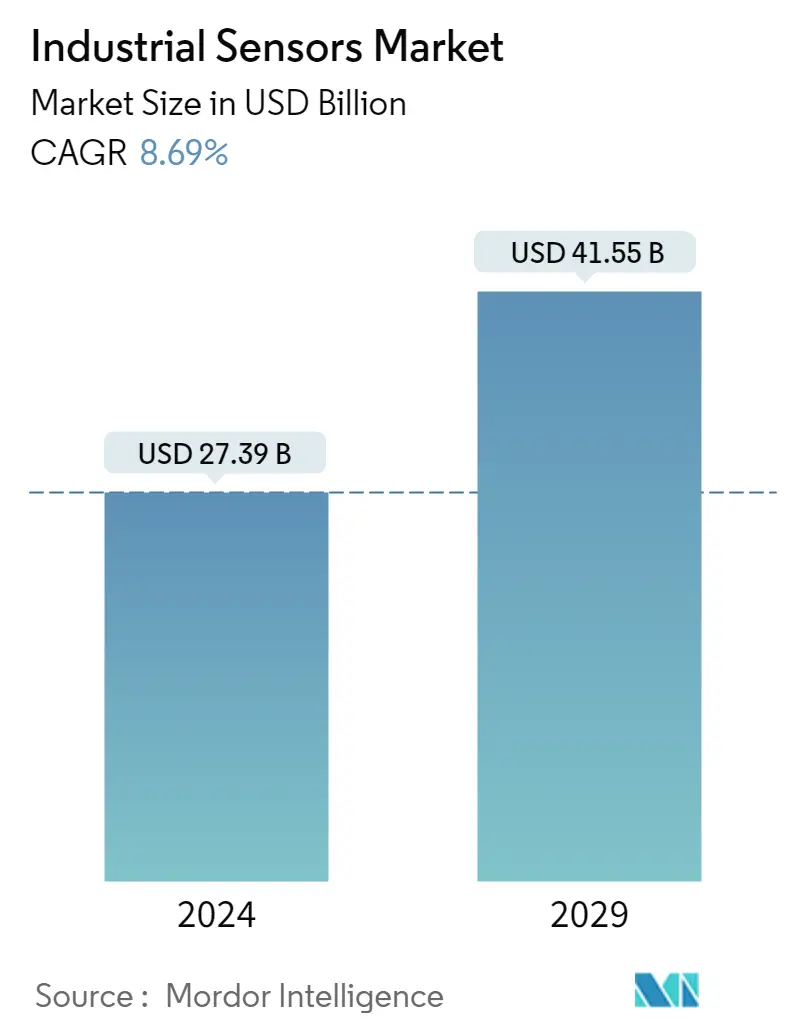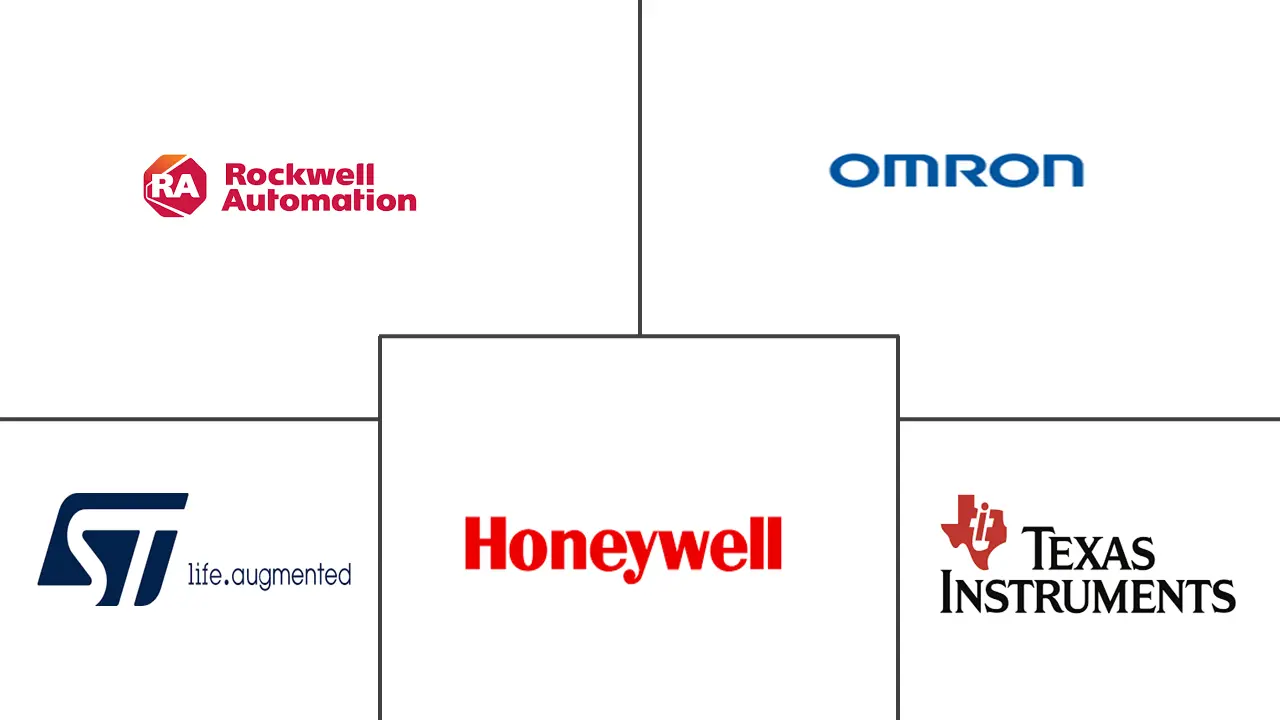Market Size of Industrial Sensors Industry

| Study Period | 2019 - 2029 |
| Market Size (2024) | USD 27.39 Billion |
| Market Size (2029) | USD 41.55 Billion |
| CAGR (2024 - 2029) | 8.69 % |
| Fastest Growing Market | Asia Pacific |
| Largest Market | Asia-Pacific |
Major Players
*Disclaimer: Major Players sorted in no particular order |
Industrial Sensors Market Analysis
The Industrial Sensors Market size is estimated at USD 27.39 billion in 2024, and is expected to reach USD 41.55 billion by 2029, growing at a CAGR of 8.69% during the forecast period (2024-2029).
The consistent and reliable performance of sensors has led the assets in heavy-industrial operations to drive critical daily metrics. Manufacturers are constantly monitoring the uptime of assets along their production lines. IIoT integrates legacy machinery commonplace within these complex industries via industrial connectivity with IIoT platforms for different use cases, roles, and applications.
- The Industrial Internet of Things enabled industries to rethink business models, generating actionable information and knowledge from IIoT devices. A data-sharing ecosystem started to have built new revenue streams and partnerships.
- The laser sensors measured 3D motion and vibrations of any surface to enable industrial manufacturers to monitor the real-time health and performance of engines, turbines, and pumps. Their compact and contactless form enables the sensors to work on hot, wet, and moving surfaces.
- Although the global automotive sector witnessed a recession in the past two years, the trend was also reflected in China. The number of sensor and sensor components increased in the sector. MEMS pressure sensors have witnessed significant adoption in the smart automotive sector over the past few years. For the same, Asystom recently launched a range of multi-sensor IIoT devices featuring increased autonomy. The multi-sensor capability has addressed the predictive maintenance needs of a wide array of industrial equipment, integrating new onboard, connected, energy-saving electronics performing in situ analysis. These innovative products, apart from increased performance, are eco-responsible and 100% upgradeable.
- The inductive proximity sensors could detect only metallic devices, whereas other sensors detect any other materials. In addition, the sensing range of an inductive proximity sensor depends on the type of metal's shape, size, and coil size used in the design. Due to this, it accounted for distance limitations for sensing. This factor regarding the sensing capability and usage of inductive proximity sensors only on metallic objects is hindering the growth of the studied market.
- As an important part of producing a superior temperature sensor, the high-quality raw materials choice is vital for the producer. Metals and alloys used while manufacturing includes platinum, copper, silicon, tungsten, nickel, and alloys, which are further categorized into type-K, type-M, type-E, and type-J. Platinum prices rose to a two-month high in May 2020, recovering from a 17-year low in mid-March, but the platinum-group metals markets are projected to remain under pressure because of the COVID-19 pandemic.
Industrial Sensors Industry Segmentation
Industrial sensors are devices that can detect events or changes in the environment and provide the corresponding output. Sensor components are not considered as part of the study scope. These sensors can sense physical input, such as light, heat, motion, moisture, pressure, or any other entity, and respond by producing an output on display or transmitting the information in electronic form for further processing.
Further, the Industrial Sensors Market is segmented by Sensing Type (Flow, Pressure, Proximity (Area), Level Measurement, Temperature, Image, and Photoelectric), End-user Vertical (Chemical and Pharmaceutical, Mining and Metal, Power, Food and Beverages, Life Sciences, Aerospace and Military, and Water and Wastewater), and Geography.
Industrial Sensors Market Size Summary
The industrial sensors market is poised for significant growth, driven by the integration of the Industrial Internet of Things (IIoT) and the ongoing digital transformation across various sectors. These sensors play a crucial role in enhancing the efficiency and reliability of industrial operations by providing real-time data and insights. The adoption of advanced sensor technologies, such as laser and image sensors, is enabling manufacturers to monitor the health and performance of critical equipment, thereby optimizing maintenance processes and reducing downtime. The market is characterized by a moderate level of fragmentation, with established players leveraging cutting-edge technologies to offer a diverse range of products tailored to meet the needs of different industries.
The Asia-Pacific region is expected to dominate the industrial sensors market, fueled by rapid industrialization and technological advancements. Countries like South Korea and China are at the forefront of this growth, with initiatives like Industry 4.0 and Society 5.0 driving the adoption of smart manufacturing solutions. The automotive, electronics, and energy sectors in these regions are significant consumers of industrial sensors, contributing to the market's expansion. Additionally, the rising demand for automation and robotics in manufacturing processes is further propelling the market forward. As companies continue to innovate and develop eco-friendly and cost-efficient sensor solutions, the industrial sensors market is set to experience robust growth in the coming years.
Industrial Sensors Market Size - Table of Contents
-
1. MARKET INSIGHTS
-
1.1 Market Overview
-
1.2 Industry Value Chain Analysis
-
1.3 Industry Attractiveness - Porter's Five Forces Analysis
-
1.3.1 Threat of New Entrants
-
1.3.2 Bargaining Power of Buyers
-
1.3.3 Bargaining Power of Suppliers
-
1.3.4 Threat of Substitute Products
-
1.3.5 Intensity of Competitive Rivalry
-
-
1.4 Technology Snapshot
-
-
2. MARKET SEGMENTATION - BY SENSOR TYPE
-
2.1 Flow
-
2.2 Pressure
-
2.3 Proximity (Area)
-
2.4 Level Measurement
-
2.5 Temperature
-
2.6 Image
-
2.7 Photoelectric
-
2.8 Other Sensing Types
-
-
3. MARKET SEGMENTATION - BY GEOGRAPHY
-
3.1 North America
-
3.1.1 United States
-
3.1.2 Canada
-
-
3.2 Europe
-
3.2.1 Germany
-
3.2.2 United Kingdom
-
3.2.3 France
-
3.2.4 Rest of Europe
-
-
3.3 Asia-Pacific
-
3.3.1 China
-
3.3.2 Japan
-
3.3.3 South Korea
-
3.3.4 Rest of Asia-Pacific
-
-
3.4 Latin America
-
3.5 Middle East & Africa
-
Industrial Sensors Market Size FAQs
How big is the Industrial Sensors Market?
The Industrial Sensors Market size is expected to reach USD 27.39 billion in 2024 and grow at a CAGR of 8.69% to reach USD 41.55 billion by 2029.
What is the current Industrial Sensors Market size?
In 2024, the Industrial Sensors Market size is expected to reach USD 27.39 billion.

